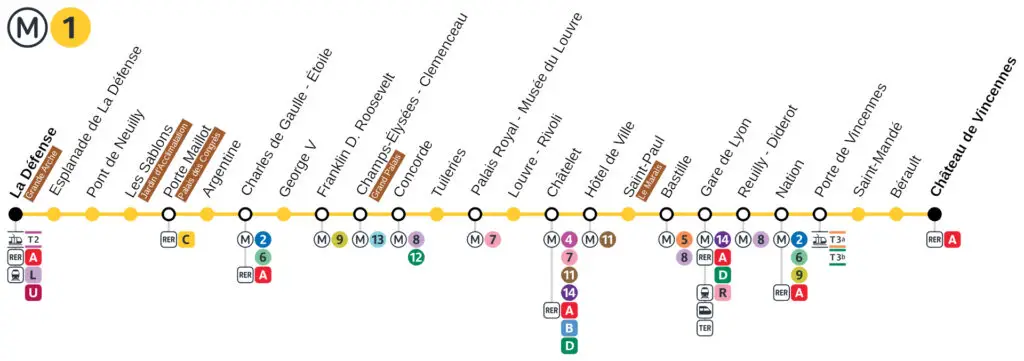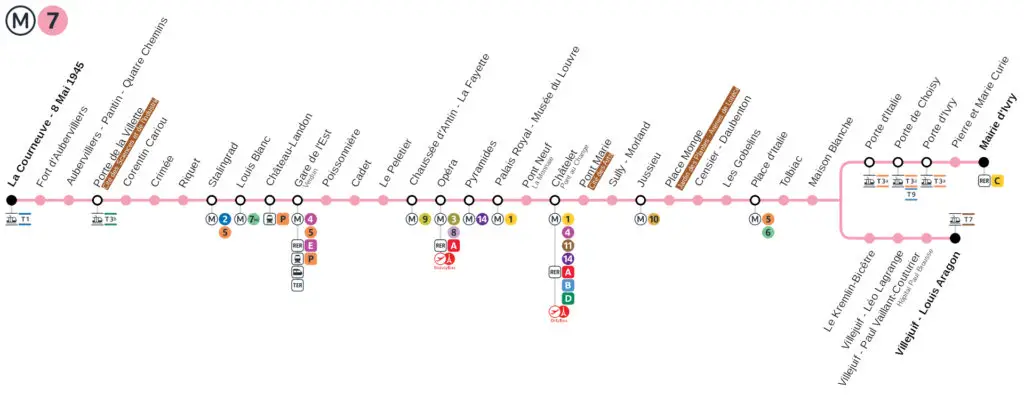Palais Royal – Musée du Louvre
City
Paris
Metro lines
1 / 7
Palais Royal – Musée du Louvre metro station
The Palais Royal – Musée du Louvre metro station is located in the 1st arrondissement of Paris, France. It takes its name from the nearby Palais Royal, a former royal palace, and the nearby Musée du Louvre, one of the world’s most famous art museums.
The Palais Royal – Musée du Louvre metro station is served by lines 1 and 7 of the Paris metro. Line 1 is the oldest metro line in Paris and crosses the city from east to west, passing such iconic landmarks as the Arc de Triomphe, the Champs-Élysées and Place de la Concorde. Line 7, meanwhile, links the northeastern suburbs of Paris with the city’s southwest, passing through districts such as the Marais, the Opera and the Latin Quarter.
The Palais Royal – Musée du Louvre metro station is very busy due to its proximity to major tourist attractions such as the Louvre, the Jardin des Tuileries and the Palais Royal. It is therefore often used by visitors wishing to visit these sites or explore the historic center of Paris.
The platforms on both lines are of standard configuration: two per stop, separated by the central metro tracks.
The line 1 station is built flush with the ground: the ceiling is made of a metal deck whose beams are supported by vertical pedestals. A 15-meter-long crypt, whose ceiling rests on closely spaced pillars, has extended the station at its western end since the line switched to six-car trains in the 1960s. Designed in the “Andreu-Motte” style, it is, along with Opéra on line 3 and Concorde on line 8, one of only three stations decorated in this way to be finished in violet, a hue that is part of the lexicon of exceptional colors in this style. It is applied to the handrails, deck beams and seats. The benches, spandrels and pedestals are fitted with large, flat white tiles with a glazed appearance, while the corridor outlets are treated with classic beveled white tiles. The advertising frames are metal, and the station name is inscribed in Parisine font on enameled plates.
Line 7’s station is curved and has an elliptical vault. It is distinguished, however, by the lower part of the pedestals, which is vertical rather than curved, and its platforms are slightly offset from one another. Like those on line 1, they are fitted out in the “Andreu-Motte” style, with two orange light railings, flat brown tiled corridor outlets and orange “Motte” seats. The latter are mounted on masonry benches covered with orange flat tiles of a smaller size than usual. This new tiling is now consistent with the lighting strips and the seats they support; however, they are no longer in harmony with the tiles at the corridor outlets, either in size or color, going against the original principles of the “Andreu-Motte” style. Beveled white ceramic tiles cover the pedestals, vault and spandrels. The stair stringers and footbridge are covered in flat white tiles aligned horizontally. The advertising frames are metal, and the station name is written in Parisine font on enameled plates.
The station has five entrances.
Inauguration of the station
The Palais Royal – Musée du Louvre metro station was inaugurated on July 19, 1900. It was one of the first lines of the Paris metro, opened to coincide with the 1900 Paris Universal Exhibition. Line 1, to which this station belongs, was the first metro line to be put into service in Paris. Since then, the station has been renovated and modernized several times to meet the growing needs of passengers.
Where does the name come from ?
The Palais Royal – Musée du Louvre metro station takes its name from two nearby landmarks.
The Palais Royal is a former royal palace located in the 1st arrondissement of Paris, just a stone’s throw from the metro station. Built in the 17th century, it was home to several members of the French royal family. Today, the Palais Royal is home to cultural institutions, boutiques, gardens and shopping arcades.
The Musée du Louvre, meanwhile, is one of the most famous and visited museums in the world. It is also located in the 1st arrondissement of Paris, close to the Palais Royal. The museum houses a vast collection of works of art, including masterpieces such as the Mona Lisa, the Venus de Milo and the Victory of Samothrace.
Thus, the name of the Palais Royal – Musée du Louvre metro station was chosen to reflect the presence of these two prestigious and symbolic sites in its immediate surroundings.
Where to go from Palais Royal – Musée du Louvre ?
From the Palais Royal – Musée du Louvre metro station, you have several options for getting to different destinations in Paris. Here are a few suggestions of interesting places accessible by public transport from this station:
- Musée d’Orsay: You can take metro line 7 from Palais Royal – Musée du Louvre to Solférino station. From there, it’s just a short walk to the Musée d’Orsay, famous for its collection of Impressionist and Post-Impressionist art.
- Eiffel Tower: Take metro line 1 from Palais Royal – Musée du Louvre to Concorde station. Then walk to Invalides metro station and take line 8 to École Militaire station, which is close to the Eiffel Tower.
- Notre-Dame de Paris Cathedral: Take metro line 7 from Palais Royal – Musée du Louvre to Pont Neuf station. From there, you can walk to the famous Notre-Dame de Paris cathedral, located on the Ile de la Cité.
- Montmartre and Sacré-Coeur Basilica: Take metro line 7 from Palais Royal – Musée du Louvre to Opéra station. Then take metro line 8 to Anvers station, which is close to Montmartre hill. From here, you can admire the panoramic view from the Sacré-Coeur Basilica.
- Marais district: Take metro line 1 from Palais Royal – Musée du Louvre to Hôtel de Ville station. You’ll find yourself in the heart of the historic Marais district, with its picturesque alleyways, boutiques, museums and restaurants.
These suggestions are just a few of the many public transport options available from the Palais Royal – Musée du Louvre station. Paris has an extensive metro, bus and RER (Réseau Express Régional) network, making it easy to reach many other sites and areas of the city.
Many public transport lines pass through this metro station: metros 1 and 7, RATP buses 21, 27, 39, 67, 68, 69, 72 and 95.
What’s nearby ?
The Palais Royal – Musée du Louvre metro station is located in a very central area of Paris, which means there are many sights and attractions nearby. Here are just a few of the notable places you can find nearby:
- Musée du Louvre: Located just a few minutes’ walk from the metro station, the Musée du Louvre is one of the world’s most famous and visited museums. It houses a vast collection of works of art, from Egyptian and Greek antiquities to Renaissance and modern masterpieces.
- Jardin des Tuileries: Right next to the Louvre is the Jardin des Tuileries, a magnificent public park with tree-lined avenues, ponds and sculptures. It’s an ideal place to stroll, relax or take a break after a visit to the museum.
- Palais Royal: Just a short walk from the metro station is the Palais Royal, a former 17th-century royal palace surrounded by gardens. Today, the Palais Royal is home to shopping malls, fashion boutiques, restaurants and cultural institutions.
- Opéra Garnier: Take metro line 7 from Palais Royal – Musée du Louvre to Opéra station, and you’ll arrive at the Opéra Garnier. This magnificent, richly decorated opera house is an architectural gem in Paris, offering guided tours as well as opera and ballet performances.
- Place Vendôme: Just a few minutes’ walk from the metro station, you’ll find the famous Place Vendôme. This square is renowned for its neoclassical architecture, luxury boutiques and iconic Victory Column.
In addition to these sights, the area is home to numerous cafés, restaurants, boutiques and art galleries well worth exploring. You can also take advantage of the Seine’s proximity to stroll along the river and discover other Parisian wonders.
Anecdote
The station appears in Gérard Oury’s film “Les Aventures de Rabbi Jacob”, in which the characters of Slimane (played by Claude Giraud) and Rabbi Jacob (played by Louis de Funès) descend into the station on a Kawasaki 100 motorcycle.

